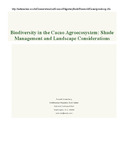| dc.description.abstract | The ability of cacao farms to harbor biological diversity—particularly forest dependent species—is known for only a few taxa (primarily ants and birds) and from a few sites. Much of what we suspect to be true of cacao farms with respect to biodiversity is based on research in similar systems (primarily coffee) or is inferred from established ecological principles. On this basis, we suggest that: 1) overall biological diversity and the diversity of forest dwelling organisms is higher in cacao plantations than non-shade crops or pastoral systems; 2( diversity will increase with an increase in both floristic and structural diversity of the shade level; 3) diversity within cacao plantations will be highest when they are located adjacent to extant patches, corridors, or large tracts of forest. Shaded plantations may play a particularly critical conservation role for migratory organisms (birds and perhaps insects) that arrive seasonally from the Temperate Zone, or from drier or higher altitude zones. For a program designed to promote traditional shade approaches to cacao cultivation we recommend the following activities: a) The firm empirical establishment of the value of traditional cacao as a conservation tool. b) The geographic and taxonomic scope of biodiversity surveys needs to be greatly expanded and conducted in a systematically comparative fashion—comparing cacao farms to other agricultural habitats, comparing among different management schemes of cacao, with the emphasis on the ability of cacao to harbor forest-dependent flora and fauna. b) A realistic assessment of the long term stability of populations of forest trees and other organisms (birds, epiphytes, fungi) in traditional cacao plantations. An evaluation of the selection of shade tree species and the mode of shade management to optimize farm productivity and biological diversity. Research would include a detailed region by region assessment of the use of shade trees by forest organisms of selected major taxa overlaid on information garnered on the silvicultural and agronomic properties of the same tree species, as well as the use and value of tree products. c) A comprehensive testing of the concept that the greater unplanned diversity of traditional farms will dampen the population outbreaks of pest and disease organisms and improve pollination levels. d) The development of a full range of incentives for farmers to grow cacao in a biodiversity friendly manner including fair-trade practices, access to pre-harvest credit, carbon sequestration credits, avitourism, and environmental funds based on taxing agrochemical inputs. | en_EN |


